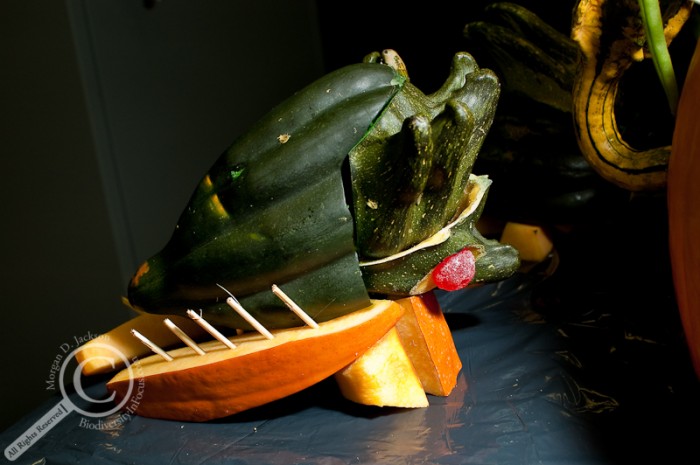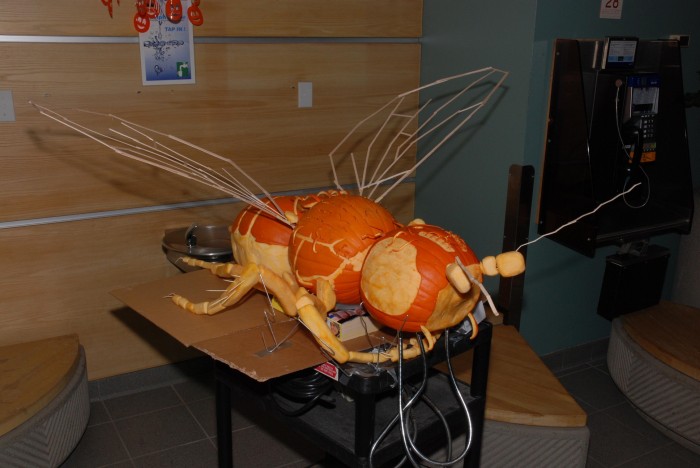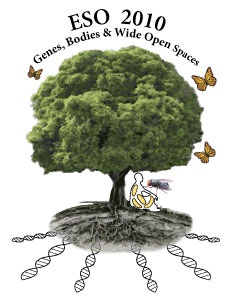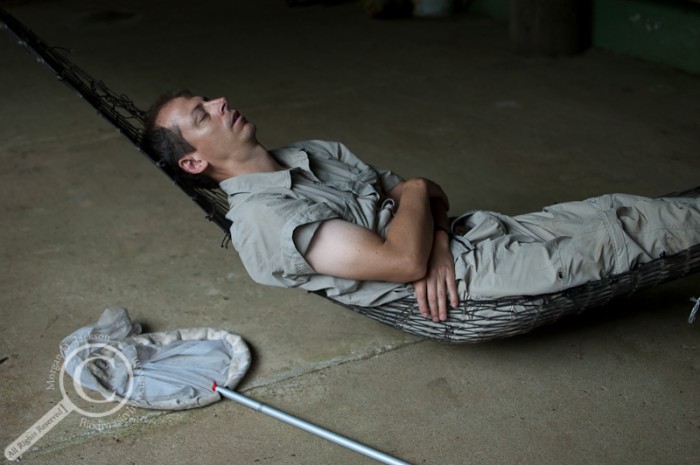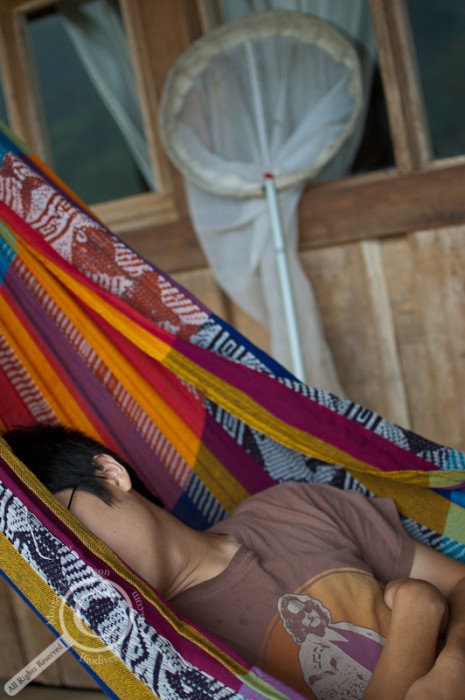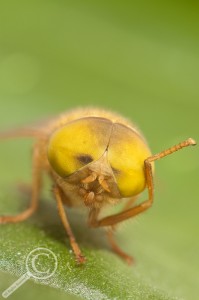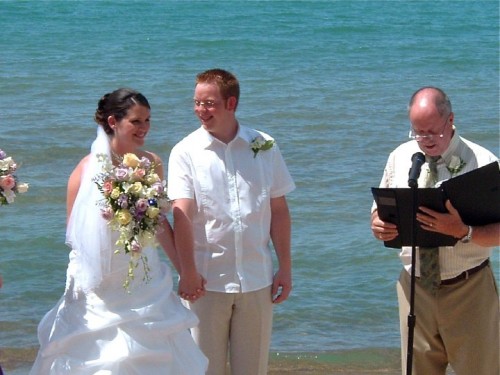2009 saw a larger crowd in our lab than previous years, so we ramped up our pumpkin to allow everyone to participate. Before we get to it though, here are a few of the side projects people made with extraneous vegetables:
Having found success with our jumping spider, we ventured further into the realm of morphological correctness, and constructed an ode to our advisor, Dr. Steve Marshall:
This lovely creature is a morphologically correct Sphaerocerid fly, right down to wing venation and the square rear basitarsus (hard to see in this picture, but it’s there, trust me). I was working in Ottawa at the time so I can’t claim any credit for this, but I believe it was another 8+ hours of work between 3-4 grad students. The sculptors incorporated a range of materials, including a wire frame for leg and head support, toothpicks for bristles and tarsal claws, and popsicle stick wing veins. As per the jumping spider, we use fiberoptic microscope lights to illuminate our creations (the silver tubes sticking out from below the head). Unfortunately there are no images of the fly lit up, but I hear it was pretty spectacular!
Well, October is all but finished, and I can hardly believe where the time has gone. Well, I know where the last week has gone at least, and that’s been busy transcribing old Hennig papers in German. This is one of the greatest challenges to the science of taxonomy in my mind, needing to critically review all prior information on the taxa of interest. Getting the papers in the first place is often an issue, especially when they’re published in obscure journals from the 1800’s, but once you have them, the real work begins trying to decipher the text. Not only is the obvious language barrier standing in the way, but also the obscure entomological terms that most translators can’t catch and, with the older papers, old lexicon which also isn’t always easily translated. With that in mind, I thought I’d share some of the resources I use for translating these papers (from languages including French, German, Portugese and Spanish).
As with most things on the internet these days, Google is my first choice, and in this case, Google Translate. I’ve found that the translations from Google are much better (when reading the results back in English, not doing a direct translation comparison) than say Yahoo’s Babel Fish (is there a trend here between search engine popularity and translation success? Hmmmm…). Even some complicated German compound words are easily readable after a quick run through Google Translate. Other pros for Google? Real-time translation, allowing you to break up those long compound words which confound the software, and the ability to upload entire Word documents to be translated at once. I find typing accented letters in a word processor much easier than online, speeding up the process in many cases (and also allowing you to save your transcribed files for later instead of evapourating into the ether of the web). I’d say that 95% of my translating needs are met with Google Translate. Another added benefit? Google recently added Latin translation, allowing you to check the etymology of taxon names, or invent your own!
Sometimes when you read over your translated text, you’ll come across a word or term that doesn’t seem to fit or make sense. In these cases I turn to the Woxikon Online Dictionary, which provides a list of synonyms for translated words. This website is only for individual words and not mass blocks of text, but it has helped me make sense of some rather odd sentences! Woxicon works for a bevy of languages (although not as extensive as Google) covering most of the languages in classic taxonomic papers.
Of course, neither of these sites are much good with detailed morphological terms, although in many instances I find I can guess the correct structure based on similarity to English, or by comparing to specimens (i.e. looking for the red sclerite on the thorax, and then determining that was the katepisternum).
Now my question to all you taxonomists (and anyone else dealing with similar linguistics issues): how do you go about translating papers? Do you have access to a multi-lingual colleague in your department, speak multiple languages yourself, or have other resources for this sort of thing? Leave your solutions below in the comments!
UPDATE: After finally finishing transcribing Hennig, I found that Google Translate had some issues translating the entire document (26 pages) and took a few tries to translate the whole thing. After finally getting everything translated, I found I couldn’t download the text, and copy & pasting resulted in both the English and German versions getting transferred in a mixed format. The solution? I uploaded my Word document to Google Docs, used the translation service (again needing 3 tries to perform the entire translation) and then downloaded the file back to my computer for reading later. Overall, easy to do (other than the need to translate it multiple times) and with pretty decent results.
One of my favourite yearly entomological events is coming up soon, and I wanted to spread the word to all those who may be interested in attending. The Entomological Society of Ontario Annual General Meeting is being held October 15-17 in Grand Bend, Ontario, and it promises to be another great meeting.
I thought I’d pass along a few entomology graduate positions that have been posted for universities in Ontario:
Pollination Ecology of Dacus carota (Umbelliferae) – M.Sc. – Dr. Fiona F. Hunter, Brock University, St. Catherines
Dr. Fiona F. Hunter has funding available to support one MSc graduate student for 2 years (effective immediately) to study the pollination ecology of Daucus carota. This includes both edible carrot and its wild relative, Queen Anne’s Lace. Daucus carota is characterized by having a dark central floret. Darwin, himself, speculated that the dark central floret may now be functionless and possibly represents a trait that has persisted long after its original function has been lost. Other researchers have postulated that the dark central floret serves to attract pollinators to the flower. This MSc opportunity will be aimed at determining what insects are common visitors to edible carrot and to Queen Anne’s Lace, how these insects affect seed set, and whether the dark central floret is adaptive or not. The student who undertakes this project will have a strong background in ecology and evolution, entomology and biostatistics.
If you are interested in this MSc opportunity, please send a covering letter, cv, unofficial transcript and a statement of interest to: Dr. Fiona F. Hunter, Department of Biological Sciences, Brock University, St. Catharines, ON, L2S 3A1 or email the documents to fhunter@brocku.ca
Speciation and Mating Systems in the Arctic Butterflies (genus Oeneis) Ph.D. – Dr. Gard W. Otis, University of Guelph
Macoun’s Arctic (Oeneis macounii) and other butterfly species in the genus Oeneis are reported to have biennial life cycles, with individuals requiring two years to develop from egg to adult. Preliminary evidence indicates that this 2‐year life cycle is obligatory in O. macounii. This presents the possibility that even‐year populations are reproductively isolated from odd‐year populations. The central question is: has allochrony caused by their two year life cycle resulted in genetic and morphological divergence between even‐ and odd‐year populations? This question will be explored through laboratory sequencing and computer analyses of both nuclear and mitochondrial DNA regions as well as landmark‐based morphometric analyses. In addition, field studies will lead to a better understanding of adult ecology, dispersal, and male‐male competition in one or more lekking species.
Applicant must have a strong interest and background in ecology and evolution as well as excellent writing abilities. Experience with entomology, DNA amplification and sequencing, animal behaviour and/or biostatistics will be strengthen your application. You must meet the minimum conditions of NSERC Scholars (i.e. citizen or permanent resident of Canada; minimum 80% average in your last two years of study). Completion of an MSc degree is preferred, but students with an honours BSc degree and very strong academic record will be considered.
If you are interested in this PhD opportunity, please e‐mail or mail a covering letter, cv/resume, unofficial transcript and a statement of interest to: Dr. Gard W. Otis, School of Environmental Sciences, University of Guelph, Guelph, ON N1G 2W1, gotis@uoguelph.ca
Please contact the advising professor if you want more information. Good luck!
…when you sleep in a volleyball net!
Hammocks seem to be the leading cause of productivity decline in Dipterists…
Flying out of Detroit this time to save some money ($400CDN for roundtrip to San Jose? Yes please!) means a longer car ride and an extra night away from home. Bummer.
We got the friendliest US Customs agents I think I’ve ever dealt with, with all 3 being really friendly and helpful, and no sign of a power trip! The guy doing our paperwork was especially great, asking a bunch of Diptera questions and breezing through the paperwork with no trouble!
Of course I realized 45 minutes down the road that I wore my good shoes and not my field shoes, and that I left half our supply of nail polish remover (it’s our method of choice for killing insects) sitting on the kitchen table, but if that’s the least of the mistakes then things will be just fine!
Free wifi in hotels = awesome.
Not having to get up at 0-dark-thirty to catch a flight also = awesome.
That pretty well sums up day 1 (who knew Detroit was this much fun…), but we go international tomorrow, and a day spent in airports should make for some more interesting stories. See you from Costa Rica!
MTC…
Ever wish there were more hours in the day sometimes? I could certainly use a few extra hours this week…
Howdy Stranger(s)! It’s been awhile since my last post, but I’ve got a good excuse: I got married!! Yep, some crazy lady said yes two years ago and June 19 was our big day! We couldn’t have asked for a better day, with beautiful weather (the wedding was on the beach of Lake Huron), lots of friends and family, and all sorts of fun!
I couldn’t ask for a greater partner to travel through life with, or one who puts up with each and every pause to check out a fly, the hours spent with a camera pressed to my face, and the field trips that take me away. Not to mention she let me use insects as table names, put plastic bugs on the tables to complement the centrepieces and butterflies on the cake! She’s definitely my greatest catch! <3

